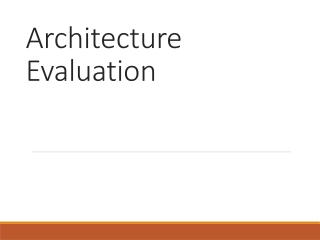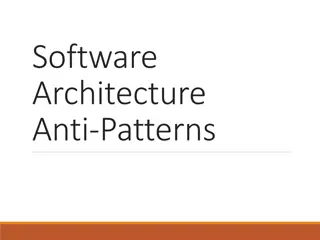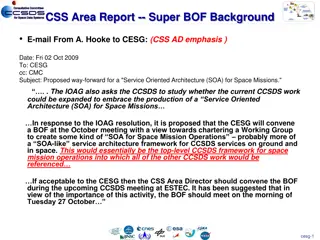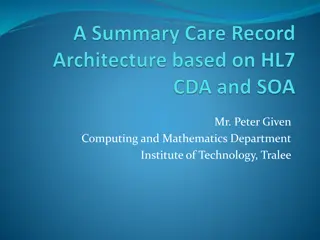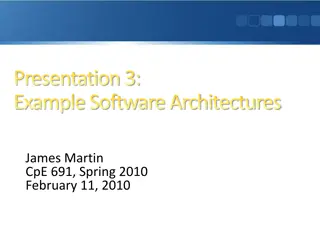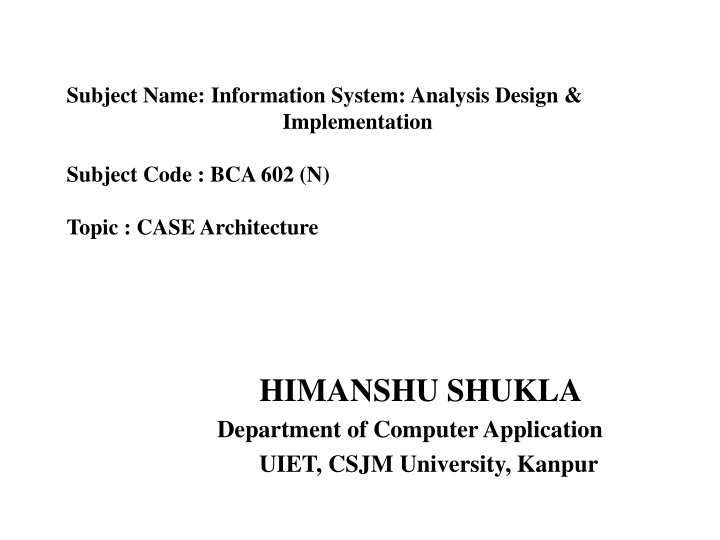
Architecture and Use of CASE Tools in Information System Design
Explore the architecture of CASE tools including the user interface, toolkit layer, object management layer, and repository layer. Learn about the use of CASE tools in analysis, design, and implementation phases of information systems within the SDLC. Discover how these tools aid in diagramming, project initiation, planning, coding, and maintenance of information systems.
Download Presentation

Please find below an Image/Link to download the presentation.
The content on the website is provided AS IS for your information and personal use only. It may not be sold, licensed, or shared on other websites without obtaining consent from the author. If you encounter any issues during the download, it is possible that the publisher has removed the file from their server.
You are allowed to download the files provided on this website for personal or commercial use, subject to the condition that they are used lawfully. All files are the property of their respective owners.
The content on the website is provided AS IS for your information and personal use only. It may not be sold, licensed, or shared on other websites without obtaining consent from the author.
E N D
Presentation Transcript
Subject Name: Information System: Analysis Design & Implementation Subject Code : BCA 602 (N) Topic : CASE Architecture HIMANSHU SHUKLA Department of ComputerApplication UIET, CSJM University, Kanpur
Architecture of CASE tool User Interface : A standard interface toolkit with common presentation protocol. The user interface contain software for human computer interface management and library of display object. It is communication medium between the interface and CASE. Toolkit Layer: It is a set of tool management services with the CASE tools . Tool Management Services control the behaviour of tools within the environment. If multitasking is used during the execution of one or more tools TMS performs multitask synchronisation and communication , flow of information from repository and object management system OMS into the tool .
Object Management Layer: It performs the configuration management function .It is framework that provides architecture mechanism for tools integration .Easy CASE tool is plugged onto object management layer . Repository Layer: It is a CASE database and access control functions that enable the Object Management Layer t interact with database .Data integration is achieved by object management and shared repository layer.
Use of CASE Tools in Analysis Design & Implementation of Information system Diagramming Tools Computer display and report generator tool Analysis tool Central Repository Documentation generator Code generator Configuration management tools Programming tools Prototyping tool Web development tools Quality assurance tool Maintenance tool Online help
CASE Tools used within SDLC Phase SDLC Phase Project Identification and selection Activity Display and structure high level organizational information Develop project scope and feasibility Determine a structured system Create new system design CASE Tool Usage Diagramming and matrix tool to create and structure information Project initiation and planning Analysis Repositories and documentation to develop plan Diagramming tool to create process logic and data models Form report generation to prototype design , analysis and documentation to define specification Code generator and analysis Design Implementation Translate design into information system Overall information system Maintenance All tools are used according to SDLC
Advantages of CASE Tools CASE tools provide maintenance support as a result of storing system specification in central repositories. Revision of system description easily and graphical representation. Support system prototyping through the capability to change specification and determine the impact of system performance.
Disadvantages of CASE Tools Conflicting use of diagrams Human task remain critical Limited function support Absence of standard methodology support

![❤Book⚡[PDF]✔ The Apollo Guidance Computer: Architecture and Operation (Springer](/thumb/21611/book-pdf-the-apollo-guidance-computer-architecture-and-operation-springer.jpg)
